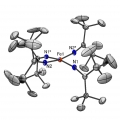Small molecule activation is the cornerstone or modern organometallic chemistry. It is a key to many important transformations, including olefin polymerization, C-H bond activation, ammonia synthesis, and water oxidation. We use metal ligand multiple bonds to coax small molecules (e.g., NO, CO, CO2, N2O, ethylene) into reactivity.







